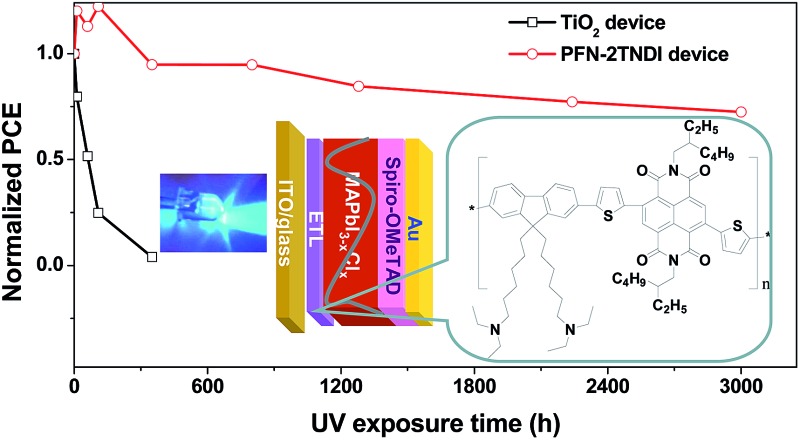- Record: found
- Abstract: found
- Article: found
Amino-functionalized conjugated polymer electron transport layers enhance the UV-photostability of planar heterojunction perovskite solar cells†

Read this article at
Abstract

Abstract
In this study, for the first time, we report a solution-processed amino-functionalized copolymer semiconductor (PFN-2TNDI) with a conjugated backbone composed of fluorine, naphthalene diimide, and thiophene spacers as the electron transporting layer (ETL) in n–i–p planar structured perovskite solar cells. Using this copolymer semiconductor in conjunction with a planar n–i–p heterojunction, we achieved an unprecedented efficiency of ∼16% under standard illumination test conditions. More importantly, the perovskite devices using this polymer ETL have shown good stability under constant ultra violet (UV) light soaking during 3000 h of accelerated tests. Various advanced spectroscopic characterizations, including ultra-fast spectroscopy, ultra-violet photoelectron spectroscopy and electronic impedance spectroscopy, elucidate that the interaction between the functional polymer ETL and the perovskite layer plays a critical role in trap passivation and thus, the device UV-photostability. We expect that these results will boost the development of low temperature solution-processed organic ETL materials, which is essential for the commercialization of high-performance and stable, flexible perovskite solar cells.
Related collections
Most cited references33
- Record: found
- Abstract: found
- Article: not found
Organometal halide perovskites as visible-light sensitizers for photovoltaic cells.
- Record: found
- Abstract: found
- Article: not found
Long-range balanced electron- and hole-transport lengths in organic-inorganic CH3NH3PbI3.
- Record: found
- Abstract: found
- Article: not found
Enhanced photoluminescence and solar cell performance via Lewis base passivation of organic-inorganic lead halide perovskites.
Author and article information
Notes
†Electronic supplementary information (ESI) available: Experimental details, AFM, UPS. See DOI: 10.1039/c7sc00077d